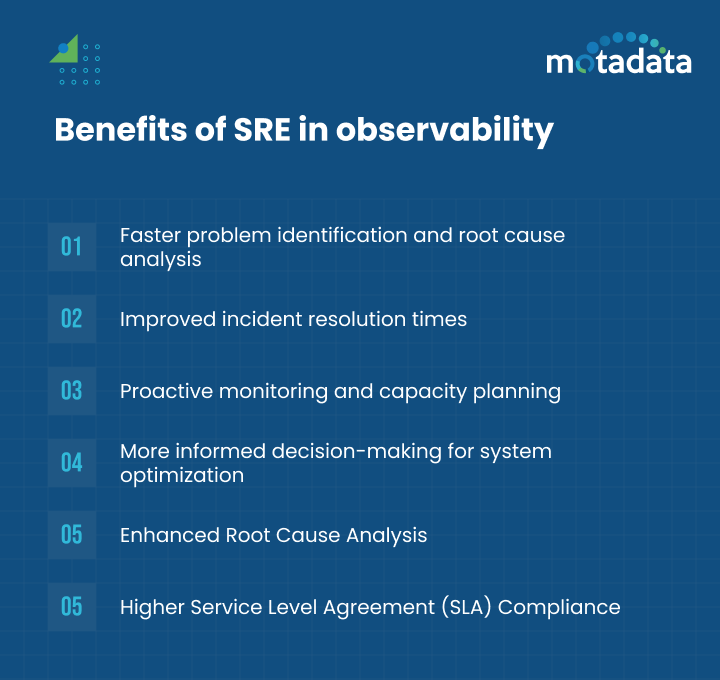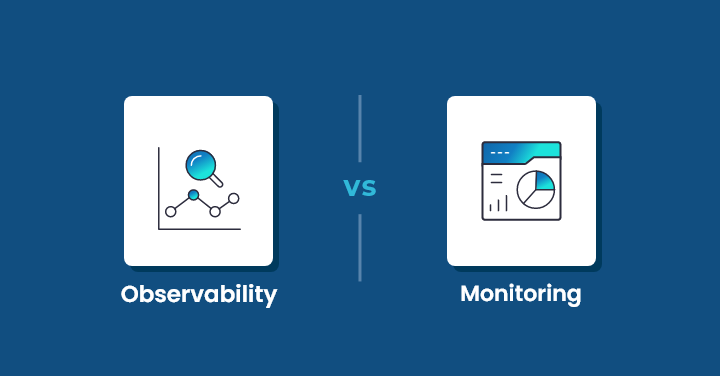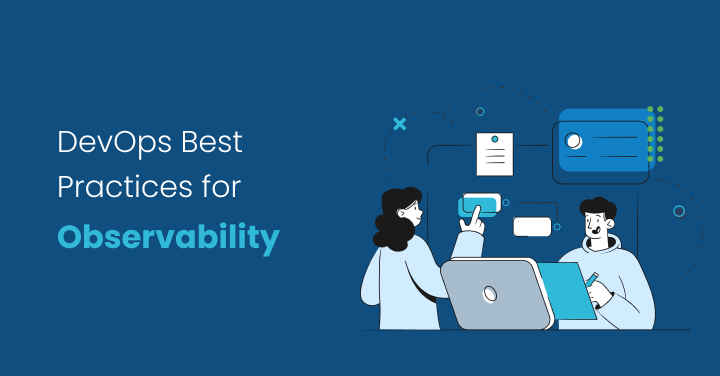Today, with every other business adopting the latest technologies, competition is becoming tough.
As a result, organizations are consistently working to improve their complex systems’ availability, reliability, and scalability to stand out.
Site Reliability Engineering (SRE)is a key discipline that works around the concept of optimizing and monitoring the software development cycle, performance, and service delivery. It integrates software engineering and IT SRE in observability.
SRE in observability
Operations to guarantee that services continue functioning properly and effectively as they grow.
However, it can also be a challenging task to manage services at scale with traditional monitoring tools.
The concept was initially introduced by Google to build resilience against failures and manage system complexities.
It involves using different methodologies and practices to manage intricate and distributed systems.
Performance bottlenecks, downtime, and inefficient resource usage are a few more challenges that businesses often face and require a comprehensive approach to tackle.
This is exactly where observability comes into play.
Observability is a crucial component of the SRE model, and its enforcement calls for the right methods and automation tools.
By adopting the practice of Observability, users can gain clear and deeper insights into a system’s internal state.
The practice goes beyond traditional monitoring, for it uses logs, metrics, and traces to conclude the internal state of each system.
Let us learn more about SRE in observability, its importance, and its role. Further, we will highlight some of the use cases of SRE Observability.
The Role of Observability in SRE
Observability practices allow DevOps to track and measure the internal state of each system by examining log data, metrics, and traces.
With the help of this concept, software engineers and DevOps teams can gain a deeper understanding of the health status of a system’s internal processes, flaws, and errors that can impact your performance.
The concept of observability in SRE works on three main pillars, i.e., logs, metrics, and traces, that enable a team of people to identify issues in real-time, enhance performance, and achieve organizational goals.
Logs: Organizations often store all the details and records related to the events that occur regularly or in a specific period in plain text.
These records are referred to as logs used for reference and analysis. A centralized log management system allows DevOps teams to track events and errors from a single console.
Further, it makes the whole process of analysis and troubleshooting much easier.
There are different log formatting standards available that make the analysis process simpler.
Using frameworks like Log4j and tools like kibana, engineers and DevOps teams can track issues in real-time.
Metrics: Another popular pillar used for establishing observability in SRE is metrics, attributes-based numerical values that update how well each component within your system is performing.
Using these metrics, you can track error rates, response time, application availability, system uptime, and more details related to an application.
These insights together help conclude how good your health status or performance rate of each hardware and software component is.
Several new tools, like Datadog, Grafana, and Prometheus, are available online to help track system metrics. These tools can provide invaluable information on potential issues and system behavior.
Additionally, you can create alerts based on metrics trends or predetermined thresholds that assist in proactively identifying and resolving issues before they worsen.
Distributed Tracing: This pillar allows team members to acknowledge the connections within the systems and services and visualize the flow of requests moving within the applications.
It provides more visibility into the pathways, transactions, incoming and outgoing requests, and response rate, which helps in better application performance management.
By tracing each component, you can identify potential issues faster and improve user experience.
Grafana and Prometheus also work great for evaluating requests and transactions thanks to tracing frameworks like Jaeger and OpenTelemetry.
Observability empowers Site Reliability Engineering by using these three pillars that contribute to understanding the exact behavior of the system.
They allow engineers to identify and resolve potential problems faster, improve system performance, and deliver better user experience.
Further, proactive monitoring made possible by observability aids SREs in foreseeing possible problems and scheduling capacity requirements before they become critical.
What are the Top Benefits of SRE in observability?
Observability is an essential best practice for Site Reliability Engineering (SRE) teams, giving them the knowledge and resources they need to manage and enhance complex systems.
By using this practice, development teams can have great benefits, such as:
1. Faster Problem Identification and Root Cause Analysis:
One of the major benefits of using observability in SRE is it helps detect issues in the system faster.
It uses log data, metrics, and traces to spot issues in real-time and take corrective measures.
The tool collects data from different sources, runs the analysis, and pinpoints the potential issues.
Further, the clear visibility provided into the system behavior using these tools allows users to identify the root cause of the problem more efficiently.
Hence, the time required to resolve the problem and fix minutes of downtime is also reduced to a good extent.
2. Improved Incident Resolution Times:
Problems must be resolved quickly to achieve SLAs and preserve system reliability.
Using the observability tool, SRE teams can gain quick insights into the system status.
This further helps diagnose incidents and implement measures to resolve them before they impact performance.
As a result, thanks to their access to rich data and insights, SREs can minimize user impact and preserve service continuity by resolving events more quickly.
3. Proactive Monitoring and Capacity Planning:
Observability not only helps identify problems but also anticipates them and prevents them from escalating.
The proactive monitoring capabilities provided by the tool allow team members to identify the fault or error at a much earlier stage.
It helps monitor unusual patterns and trends responsible for the issue.
This insight enables Site Reliability Engineering teams to address the incident before it impacts performance.
Also, the information collected is used for capacity planning to meet future demand and make more informed decisions about scaling resources.
Read Also: Proactive Network Monitoring: A Key to Network Reliability
4. More Informed Decision-Making for System Optimization:
Data-driven decision-making is an essential component of successful SRE processes.
Observability gives Site Reliability Engineering teams access to the data they need to comprehend system behavior and performance.
These insights help boost performance and improve user experience by locating real-time issues and troubleshooting them before escalating.
Also, timely response to incidents and resource management help create an efficient system.
5. Enhanced Root Cause Analysis:
Root cause analysis is another advantage that helps enhance the overall process.
Observability tools collect data from different sources and consolidate them in a single console for better analysis.
This helps DevOps teams understand the functioning of a chain of events and what exactly resulted in the problem.
With enhanced root cause analysis, you can make appropriate decisions and fix the issue for the long term, as well as prevent a similar issue from reoccurring in the future.
6. Higher Service Level Agreement (SLA) Compliance:
Meeting SLAs requires maintaining high levels of system performance and availability.
To accomplish this, observability is essential since it gives SREs the insight they need to ensure IT operations tasks are working at peak efficiency.
It helps Site Reliability Engineering teams fulfill SLAs by facilitating proactive monitoring and efficient root cause analysis.
This increases customer satisfaction while also fostering a sense of trust and dependability in the services offered.
Use Cases of SRE Observability
1. Banking
SRE Observability practices are implemented in banking to track financial transactions and online payments.
These tools allow SREs to swiftly identify and handle any challenges that may develop by gathering and analyzing data from the many systems and applications in these transactions.
In short, Observability tools improve the security and compliance of financial operations and assist in ensuring these transactions’ availability.
Further, Proactive capacity planning is possible, which helps banks scale their systems effectively.
2. Healthcare
With SRE observability, real-time monitoring and analysis of patient data is possible in the healthcare industry.
For instance, a hospital’s Site Reliability Engineering team could put up a system to monitor vital signs and identify any irregularities in patients.
This would make it possible for the medical personnel to act swiftly and avert possible medical crises.
Additionally, the SRE team may monitor the hospital’s whole infrastructure via observability tools, looking for any bottlenecks or performance problems that would affect patient care.
Hospitals can guarantee they provide high-quality care while simultaneously streamlining their processes by utilizing this practice.
3. Logistics
Logistics operations must be observable in SRE to sustain service performance and availability.
Engineers are provided the ability to track important data like inventory levels and package delivery times through a 3PL logistics provider.
For instance, you can track if your inventory is running short or if shipment delays.
These metrics are further used to diagnose problems and spot anomalies swiftly.
Delivering success rates and other Service Level Indicators (SLIs) allows SREs to identify and fix problems before they affect consumers proactively.
Furthermore, by offering insights into bottleneck locations and pinpointing areas for development, SRE observability can aid in optimizing logistical operations and improve route optimization.
4. Telecommunications
Telecommunications companies use a wide range of networks and complex infrastructure to provide quality service to their customers, ensuring minimal interruption.
With observability, you can track the performance of each network and identify outage issues or request latency problems in real-time.
Thus, you ensure minimal downtime and high availability of communication service at all times, resulting in a better user experience.
5. E-commerce
In the e-commerce business, a minor fault in the network, cloud computing, software product development services, or application can impact sales.
Hence, staying up-to-date with website traffic, performance, and availability is essential, which is impossible with traditional monitoring practices.
However, using observability tools to monitor, detect, and manage website queries can deliver a better result.
It even helps manage server issues, especially when a website is about to encounter heavy traffic due to a sales event.
Observability in SRE for e-commerce businesses can help maintain a better shopping experience, reduce bounce rates, and improve sales count. To achieve this, integrating advanced monitoring tools with OMS systems allows seamless tracking of inventory and order processing, ensuring smooth operations and enhanced customer satisfaction.
Motadata is a platform that provides observability solutions for SRE
Motadata is a unified AI-driven observability platform with new features and capabilities.
This powerful platform allows organizations to record all important metrics, track all transactions in real-time, and monitor logs.
Companies with these deep insights can even identify anomalies before they harm users.
Some of the world’s leading enterprises, like Kotak Securities, Union Bank of India, and many others, are already using this platform to monitor the internal state of their systems.
Here are some of the key features of Motadata that benefit Site Reliability Engineer:
- Unified Platform: This comprehensive solution allows businesses to manage all of their traces, metrics, and logs from a single platform, eliminating the need to purchase various tools and solutions to manage reliable software systems and development work.
- Real-time monitoring and alert: Detect issues and send immediate alerts to the Site Reliability Engineering teams for analysis and troubleshooting. Integrating and examining logs, analytics, and traces can help you quickly and accurately identify issues. This allows you to make informed decisions and take appropriate action to resolve problems swiftly.
- Customizable dashboards and visualizations: SREs can customize system performance views and examine data more easily. Further, offers interactive and intuitive insights.
- Automated workflows: Automation features streamline the whole process of identification, diagnosis, and problem resolution. Further, they enable quicker incident management and reduce human effort, which helps improve workflows and increase system reliability.
- Streamlined Workflows: Automates all the manual tasks by integrating with other DevOps tools for streamlined workflows. This allows team members to focus on other crucial areas and operations tasks.
Conclusion
Observability plays a key role in accelerating SRE practices and ensuring the smooth working of complex systems.
It provides deep insights into the health and performance of systems, performs root cause analysis for issues detected in internal systems, and troubleshoots them in real time.
With observability tools, various industries can maintain high service levels and production environments.
Motadata is a comprehensive observability platform that has grabbed much attention in recent years thanks to its excellent features.
Using Motadata, your operations teams can gain a unified view of all the data collected from multiple sources, perform real-time monitoring, and automate workflows.
Further, the robust tools offer seamless integration with existing DevOps tools.
It will not only help improve your production systems but also help achieve higher organizational goals.
FAQs
Observability is essential for SRE practices, providing deeper insights into complex systems’ health status and quick updates on their performance and availability.
By investing in observability tools, Site Reliability Engineering teams can analyze data collected from multiple sources in one place, identify and resolve issues, ensure availability, and optimize performance. Further, it enhances incident response time, looks after required capacity, and accelerates SRE practices.
Several observability platforms are available in the market, for example, Motadata, which SRE teams can use to implement this practice and collect logs, metrics, and traces from different sources in one place.
By setting this practice, the team members can perform real-time monitoring, get instant alerts, and represent customizable insightful reports for streamlined workflows. In addition to this, you can enhance the whole process by automating incident response processes.
Automation plays a very important role in SRE observability as it helps streamline the complex processes of identifying, analyzing, and resolving issues. It further reduces manual intervention, which means there are fewer chances of human errors.
Further, incident response time may be improved with the automation process. Overall, it will improve system reliability and free the teams to focus on other critical areas and strategize their work. Automation contributes to the overall efficacy of SRE by guaranteeing that these techniques are effective, scalable, and consistent.









